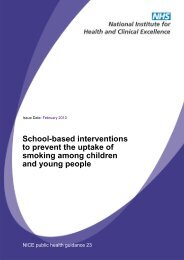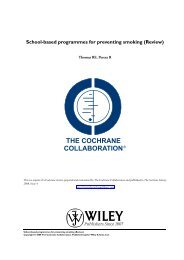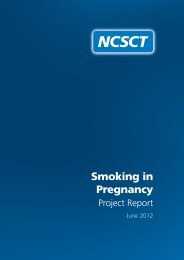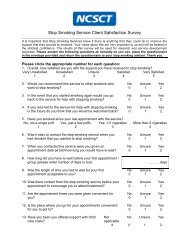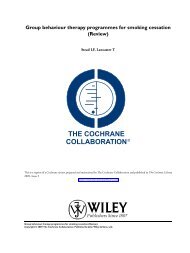Smoking and mental health - NCSCT
Smoking and mental health - NCSCT
Smoking and mental health - NCSCT
Create successful ePaper yourself
Turn your PDF publications into a flip-book with our unique Google optimized e-Paper software.
Epidemiology of the association between smoking <strong>and</strong> <strong>mental</strong> disorders 4<br />
included studies also assessed the relationship between smoking <strong>and</strong> onset of<br />
eating disorders, 51 <strong>and</strong> found no clear association between smoking <strong>and</strong> the<br />
incidence of purging (OR = 0.9, 95% CI 0.3–2.5) or binge eating (OR = 1.4,<br />
95% CI 0.6–3.0) in females. 51<br />
4.9 <strong>Smoking</strong> <strong>and</strong> depression<br />
We identified 47 longitudinal studies of smoking <strong>and</strong> depression in our<br />
searches. 3,21,24,26,27,47,54–94 One cohort was reported in two studies, 63,84 the Add<br />
Health cohort in three studies, 55,80,93 <strong>and</strong> the Teenage Attitudes <strong>and</strong> Practices<br />
Survey (TAPS) also in three studies 54,78,83 (see Table A6).<br />
4.9.1 <strong>Smoking</strong> <strong>and</strong> onset of depression<br />
There were 32 studies of the effect of smoking on the onset of depression, most<br />
of which included males <strong>and</strong> females combined <strong>and</strong> some of which provided<br />
gender-specific estimates for males 54–58,60 or females; 54–56,59,60,76,90,91 the latter<br />
group included three studies of postpartum depression. 76,90,91<br />
A meta-analysis of 26 studies found regular or daily smoking significantly<br />
increased the risk of onset of depression by 52% (RR = 1.52, 95% CI 1.36–1.71;<br />
I 2 = 68% – Fig 4.4), 24,47,54–75,86,87 with a slightly larger magnitude of effect in<br />
females (RR = 1.79, 95% CI 1.24–2.58) than in males (RR = 1.39, 95% CI<br />
1.15–1.68). Similar findings were seen in two studies that could not be included<br />
in the meta-analysis (IRR = 1.28, 95% CI 0.76–2.16; 3 light smoking: HR = 1.29,<br />
95% CI 0.74–2.25; moderate smoking: HR = 2.01, 95% CI 1.17–3.43; heavy<br />
smoking: HR = 4.34, 95% CI 1.85–10.18 94 ); however, no effect was seen in a<br />
further study assessing the association between daily smoking <strong>and</strong> the onset of a<br />
depressive disorder (RR = 1.0, p = 0.9 26 ). A subgroup analysis of the 26 studies<br />
found similar magnitudes of effect for the association between smoking <strong>and</strong> the<br />
onset of depression in adolescents (RR = 1.49, 95% CI 1.25–1.77, I 2 = 69%, 11<br />
studies) <strong>and</strong> in adults (RR = 1.56, 95% CI 1.32–1.83, I 2 = 67%, 15 studies) (test<br />
for subgroup difference p = 0. 71) (Fig 4.5).<br />
A meta-analysis of six studies found that ex-smokers were no more likely to<br />
develop depression than never smokers (RR = 1.02, 95% CI 0.82–1.27, I 2 =<br />
60%), 56–58,60,71,75 <strong>and</strong> one study found no significant association between being a<br />
former smoker <strong>and</strong> the risk of onset of depression compared with being a<br />
current smoker (RR = 0.88, 95% CI 0.56–1.40). 86<br />
Three studies 76,90,91 (see Table A6) assessed the association between smoking<br />
<strong>and</strong> postpartum depression <strong>and</strong> revealed a twofold increase in the risk of<br />
development of postpartum depression in women who were smokers during<br />
pregnancy (RR = 2.08, 95% CI 1.50–2.91, I 2 = 0% – Fig 4.6).<br />
© Royal College of Physicians 2013 71




